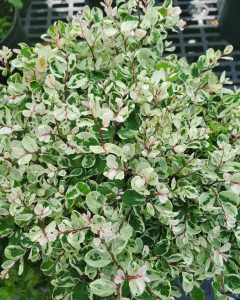
Have you seen or heard about the snowbush? For years it was a fairly common and attractive shrub that decorated many landscapes in Charlotte County. Snowbush shrubs have attractive variegated white, green, and pink/red colored foliage that really catches the eye. However, for every plant there is often an accompanying pest, and the snowbush has such a nemesis – the snowbush spanworm! This colorful and curious insect pest has a habit of defoliating their favorite food – the snowbush – to the distain of every gardener. Some gardeners were so flummoxed by the pest, that they gave up growing snowbush and many specimens faded from the landscape. The snowbush is still available and is a worthy ornamental plant. Let’s take a closer look at the snowbush as a subject for the landscape and how we can protect it from the notorious spanworm.
The snowbush, botanically known as Breynia, is available as a five to eight foot-tall, rounded shrub with red wiry branches, and as mentioned before, colorful variegated foliage. There is also a dwarf form which will stay around two-feet tall. Much of the new growth is whitish to green and white giving the plant its wintery name. Superior as an informal (but not severely pruned) hedge, the snowbush will also develop into an almost vase-shape shrub when given enough room. Although not able to tolerate salty conditions, the snowbush has high drought tolerance and will do well even in light sandy soils. Full sun is necessary for good color and dense growth. Additionally, the snowbush is a Florida-Friendly Landscaping™ approved plant and “not a problem species” according to the UF/IFAS Assessment of Non-Native Plants in Florida’s Natural Areas.
So, the snowbush is a recommended plant that will add color and interest to your landscape – good to go. However, what about the spanworm? This attractive inch-long yellow and black caterpillar is the larva of the white-tipped black moth. The larvae are called spanworms because they are really a type of inchworm which makes long, looping advances as it moves. After feeding and often stripping the snowbush of fifty percent or more of its leaves, (and in some severe cases eating the twigs and bark) the mature larvae move to the ground and pupate. The moth eventually emerges and lays pinkish-orange eggs on the snowbush stems. Most moths are active at night, but the white-tipped black moth is unusual in that it is a day-flying moth – be on the lookout.

As is often the case within natural systems, predators and parasites will help suppress the populations of spanworms for the most part. However, if the damage goes beyond what you can bear in your landscape, consider using a product containing Bacillus thuringensis or Bt, that only kills caterpillars and is particularly affective against small caterpillars. Spanworm caterpillars can also be controlled with Spinosad as per the label directions. As always, before using any pesticide, please make sure to read the label – it is the law! Once an average infestation is under control, your snowbush should flush back to normal in short order.
The moral of this story is that there is no perfect plant – there will always be advantages and disadvantages to any landscape subject and pests that cause us some heartache. However, I would still encourage you to check out the snowbush and be willing to monitor for indications of spanworms as any good gardener should – a good, best management practice! For more information on all types of shrubs and their insect pests in the landscape, or to ask a question, you can also call the Master Gardener Volunteer Helpdesk on Mondays, Wednesdays, and Fridays from 1 to 4 pm at 764-4340 for gardening help and insight into their role as an Extension volunteer. Ralph E. Mitchell is the Director/Horticulture Agent for UF/IFAS Extension Charlotte County. He can be reached at 941-764-4344 or ralph.mitchell@charlottecountyfl.gov. Connect with us on social media. Like us on Facebook @CharlotteCountyExtension and follow us on Instagram @ifascharco.
Resources:
Gilman, E. F. (2022) Brynia disticha – Snowbush. The University of Florida Extension Service, IFAS.
The Florida-Friendly Landscaping™ Guide to Plant Selection & Landscape Design (2022) The University of Florida Extension Services, IFAS
UF/IFAS Assessment of Non-Native Plants in Florida’s Natural Areas. (2023). The University of Florida Extension Service, IFAS.
McCormick, K. & Dale, A. (2024) Snowbush spanworm (larva), white-tipped black (adult), Melanchroia chephise (Stoll) (Insecta: Lepidoptera; Geometridae: Melanchroia). The University of Florida Extension Service, IFAS.
 0
0
